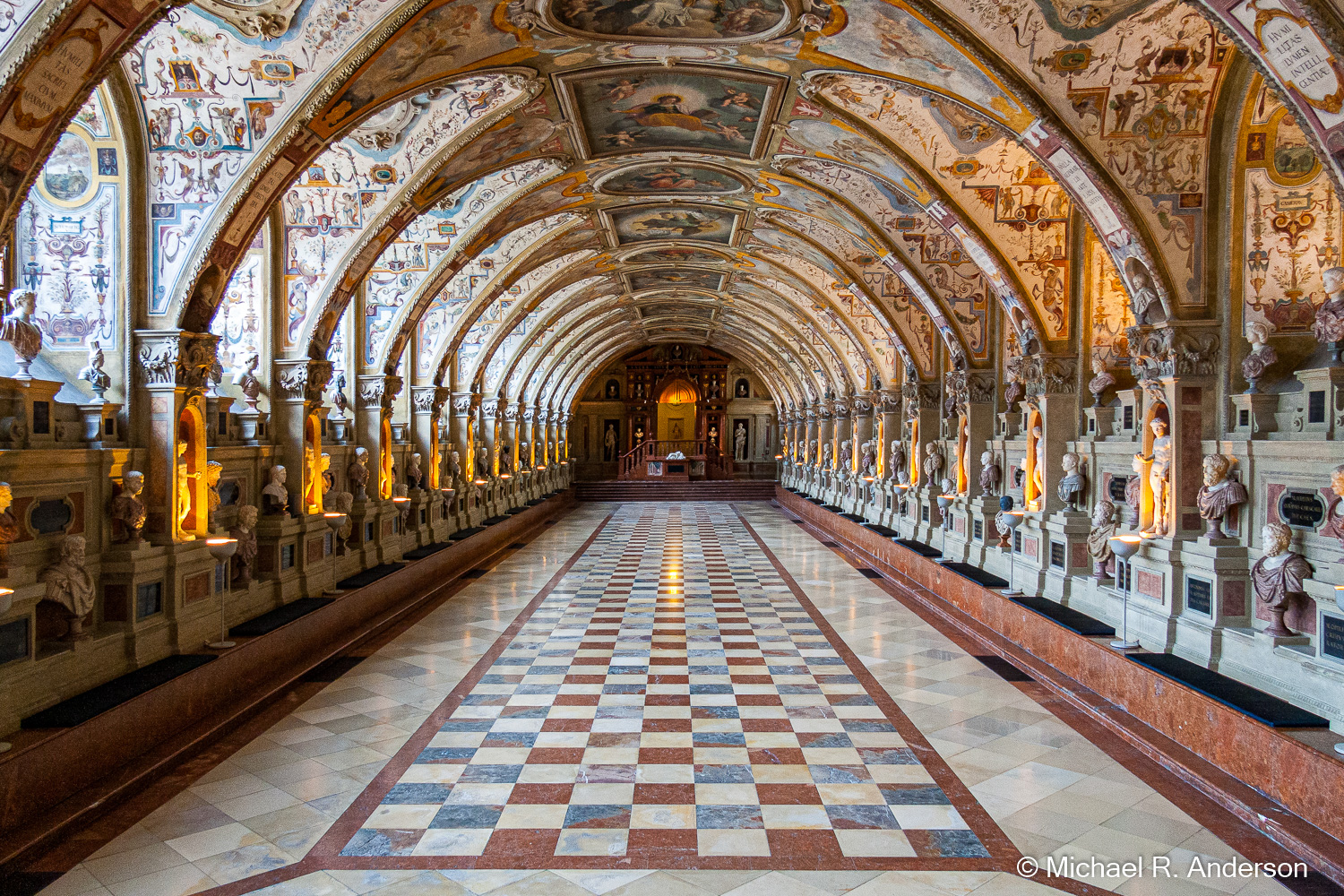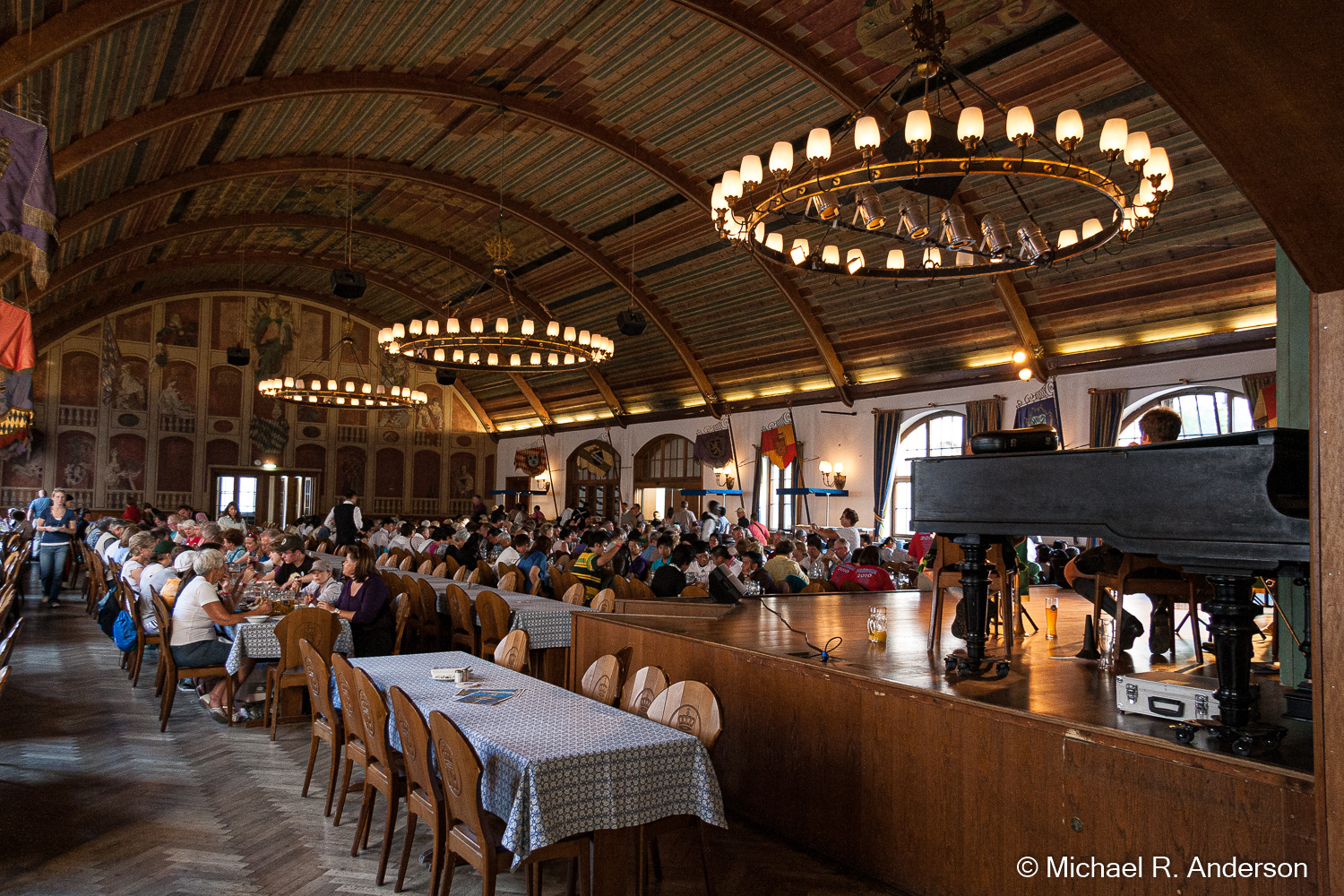As you would expect to find in many large old European cities, Munich has palaces. The Residenz, on the edge of Old Town in central Munich, is the former royal palace of the Wittelsbach monarchs of Bavaria. It was not just their place of residence, but also the seat of government for all Wittelsbach dukes, princes, and kings from 1508 – 1918. The Residenz is the largest city palace in Germany and is known for its architecture, room decorations, and displays from the former royal collections. With 130 rooms and 10 courtyards, our visit touched on only a part of it.

We wandered randomly through this enormous palace, occasionally stopping to overhear what was being said to some of the guided tour groups. There are so many paintings, tapestries, statues, art, and gardens in the Residenz that it is very difficult to describe. Even the doors and windows are amazing works of art. They must have known that I was coming because my initials were on the ceiling of one of the rooms. Instead of using words, the best thing I can do is stop typing and simply illustrate the opulence in photographs.
(Click on any photo to enlarge, use arrows (< >) to scroll through the images, then use ESC key to return.)
Leaving the Residenz, we walked through the Hofgarten. In the center sits the Diana Temple, a twelve-sided gazebo from the Renaissance period. Our destination was Munich’s English Garden, where we planned to have a relaxing afternoon. This garden, with an area of 914 acres, is considered to be one of the world’s largest urban public parks, even larger than New York’s Central Park. It was named English Garden because it was not laid out as a geometrically designed French Baroque garden, but in the natural style of an English landscape park.
As we walked we could see the Monopteros in the distance. This small, round, Greek style temple with ten columns sits atop a man-made hill. Climbing the hill not only gives you a closer look at the temple, but it also offers nice views of Munich’s cityscape. Part of the garden consists of large grassy areas along the Isar River that are popular for sunbathers. Other parts have paths winding through a cool wooded area. After wandering through the garden for quite a while, we realized that we didn’t know exactly where we were. Fortunately, as our hunger grew we came upon a small beer garden. I don’t remember what kind of sandwiches we ordered, but they came on some very tasty and interesting-looking bread.
Continuing our walk, we eventually reached the Eisbach River, a small, 1.2-mile long, man-made river that is a side arm of the Isar. And here, much to our surprise and hundreds of miles from the ocean, we discovered surfers! The Eisbach contains a standing wave that is about 3 – 4 feet high. The water is very fast, very cold, and quite shallow so it is only recommended for experienced surfers. The surfers line up along the shore and one person at a time challenges the wave. When that person wipes out and is washed downstream, the next person takes their turn. People have been surfing here since 1972 and, according to guide books, competitions have even been held here. I could hear the Beach Boys singing in my head as I watched.
You may not be aware of this if you haven’t been to Germany, but the Germans are rather fond of beer, or as they call it, bier (pronounced “beer”). If you go there you might want to visit a little pub called the Hofbräuhaus. This is considered to be the most famous beer hall in the world and, holding up to 5,000 imbibers, it is the largest in Munich. The Hofbräuhaus is also the oldest beer hall in Munich, established in 1589 by the Duke of Bavaria as the official Royal Brewery. Later it became publicly owned and is operated by the Bavarian Government.

Some interesting facts to ponder over a beer are:
- The beer is brewed in accordance with the Bavarian purity law, which was enacted in 1516. This was the world`s first food law and is still valid today.
- Regular customers keep their beer mugs (tankards) stored on the premises. There are over 400 tankard lockers located around the main area of the beer hall, some of which have been handed down from generation to generation (kind of like season tickets for the Green Bay Packers).
- The management has always catered to regulars, most of whom are members of groups. Groups can reserve tables for their use, with the oldest reservation having lasted for 70 years (so far).
- Bavarian oom-pah bands actually know songs from the ’60s, the 1860s that is.
If you go, make sure you’re thirsty because the beer is sold only in 1-liter mugs.
(Beer mug photo by Wikiuser100 – Own work, CC BY-SA 4.0,
https://commons.wikimedia.org/w/index.php?curid=40468013)
As I have done in some of my previous posts, I’ll finish with a few remarks about the fate of Munich in World War II.
When the war started, Museums were closed and emptied of their treasures for safe-keeping. Much of the city’s art, however, was still vulnerable. In 1944, when the loss of the war was inevitable, the Nazis saved as much as they could, often hurriedly cutting paintings out of their frames. They also took many photographs to document the famous and historic structures. By 1945, after 71 allied bombing raids, about 50 percent of Munich, including much of the historic center of the city, had been destroyed.
When Germany began to rebuild after the war, local commissions were established to decide if they should restore the old cities or build new ones. While Frankfurt voted to bulldoze the ruins and start over, Munich elected — by a small margin — to rebuild its old town. The photographs taken by the Nazis actually helped the city with it’s efforts. Strict regulations maintain Munich’s Old World ambience. For example, buildings cannot exceed the height of the church spires.
The reconstruction of the old city was a project that took decades; the initial phase lasted well into the 1980s. As a result, many, if not most, of the photos in this post are of faithful restorations rather than the original historic buildings. Many have said that facsimiles cannot replace originals. That may be true, but Munich has an old-world charm that was impossible for me to ignore.
If you’d like to read some older posts of our travels through Germany, check out a tour of the BMW factory, a fashion show in Berlin, a visit to the Berlin Wall, and observations from a small town in Germany.